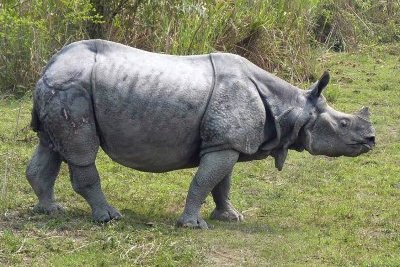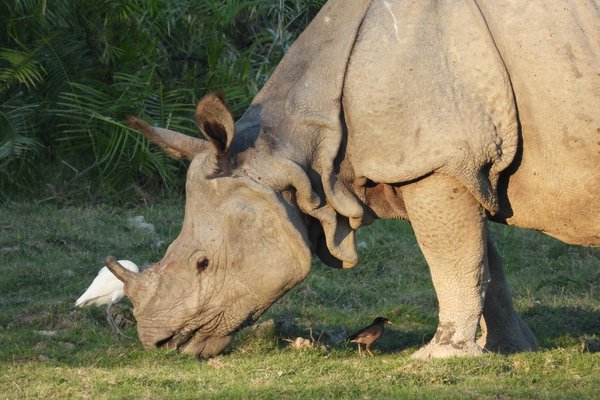India
Kaziranga National Park
Kaziranga National Park comprises wet alluvial grasslands, home to the world's primary protection area for the Indian rhino.
The park’s ecosystem consists of tall elephant grass, marshland, shallow pools and dense tropical moist broadleaf forests, crisscrossed by four major rivers, including the Brahmaputra. Two-thirds of the world's remaining Indian rhinos live in the park. Kaziranga also has a high density of tigers and large breeding populations of elephants, water buffalo and swamp deer. It is an important area for migratory birds at the junction of the Australasia and Indo-Asian flyways.
Community Perspective: The park is well-developed for tourism and provides the best viewing of rhinos in Asia. Due to seasonal flooding, it is only open from October or November to April. Solivagant was "lucky" to see both a tiger and the results of poaching. Els compares 3 of the different areas in the park.
Site Info
Official Information
- Full Name
- Kaziranga National Park (ID: 337)
- Country
- India
- Status
-
Inscribed 1985
Site history
History of Kaziranga National Park
- 1985: Inscribed
- Inscribed
- Type
- Natural
- Criteria
- ix
- x
Links
- UNESCO
- whc.unesco.org
- Official
-
- kaziranga.nptr.in — Kaziranga National Park and Tiger Reserve
- Related
-
- mammalwatching.com — Trip report with great photos
All Links
UNESCO.org
- whc.unesco.org — whc.unesco.org/
Official Website
- kaziranga.nptr.in — Kaziranga National Park and Tiger Reserve
Related Resources
- mammalwatching.com — Trip report with great photos
News Article
- Feb. 1, 2021 hindustantimes.com — Rhino kills forest department staff in Assam’s Kaziranga National Park
- July 20, 2020 bbc.com — Assam flooding: Several rare rhinos die in India's Kaziranga park
- July 16, 2017 timesofindia.indiatimes.com — Assam flood: Animal casualty in Kaziranga at 73
- Aug. 4, 2016 indianexpress.com — Assam Floods: Adult rhino carcass found in Kaziranga
- March 25, 2014 timesofindia.indiatimes.com — Kaziranga loses third rhino in five days
- June 30, 2013 firstpost.com — Assam prepares to battle floods in Kaziranga
- Sept. 28, 2012 gulfnews.com — Another rhino in Kaziranga shot at, horn chopped off
- Aug. 8, 2012 telegraphindia.com — Indian Supreme Court bans tourism in core areas of Tiger Reserves
- May 1, 2012 timesofindia.indiatimes.com — Camera traps spot 118 tigers in Kaziranga
- Sept. 3, 2011 timesofindia.indiatimes.com — Barely four days after a group of poachers killed a female rhino inside Kaziranga National Park and took away its horn, the World Heritage Site lost another rhino on Friday. Forest guards found the carcass of a rhino calf
- Aug. 31, 2011 timesofindia.indiatimes.com — Rhino killed in Kaziranga, again
- July 20, 2011 worldheritagesite.org — Floodwaters enter Kaziranga, steps taken to protect animals
- June 6, 2011 articles.timesofindia.indiatimes.com — Poachers kill rhino in Kaziranga, chop off its horn
- April 12, 2009 deccanherald.com — Dutch tourist killed by wild elephant in Kaziranga
- Sept. 14, 2008 newstrackindia.com — Floods submerge 80 per cent of Kaziranga National Park
- Aug. 19, 2008 assamtribune.com — Reprieve for Kaziranga: Expansion of NH-37 halted
- Jan. 23, 2008 timesofindia.indiatimes.com — Poachers killed a female rhino and its calf when they strayed out of the Kaziranga national park.
Community Information
- Community Category
- Wildlife habitat: Fauna
Travel Information
Seasonal WHS
Recent Connections
-
Golden jackal
-
Perfect Inscriptions
1985 -
Brahmaputra Basin
On the banks of the Brahmaputra
Connections of Kaziranga National Park
- Individual People
-
-
Lord Curzon
After his wife visited Assam in 1904 to see 1 horned Rhino - and failed to do, Curzon created Kaziranga Reserve Forest which formed the basis of the later NP.See en.wikipedia.org
-
- Geography
-
-
Brahmaputra Basin
On the banks of the Brahmaputra
-
- Trivia
-
-
Total Solar Eclipse since Inscription
21/22 July, 2009
-
- Ecology
-
-
Endemic Bird Species
Assam Plains EBA, Kaziranga IBA: Marsh Babbler (Pellorneum palustre), Black-breasted Parrotbill (Paradoxornis flavirostris) -
Oxbow lakes
"The gangetic dolphin is also found in some of the closed oxbow lakes." (AB) -
Otters
Smooth-coated otter, small-clawed otter -
Bovines
Gaur (Indian Bison), wild water buffalo -
Elephants
Asian elephant (Indian Elephant) -
River Dolphins
Ganges river dolphin -
Critically endangered fauna species
White-bellied Heron (< 250 individuals), Slender-billed Vulture (730-870 remaining), White-rumped vulture (4000-6000 remaining) -
Strepsirrhini
slow loris -
Rhino habitat
the world’s major stronghold of the Indian one-horned rhino (OUV) -
Tiger habitat
-
Bears
Asiatic Black Bear, Sloth Bear -
Bird Migrations
The African-Eurasian Flyway -
Over 300 bird species
“more than 480” (IUCN Outlook 2020) -
Pelicans
"There is a pelican rookery (grey pelican) near Kaziranga village" (AB ev) -
Pangolin
Chinese pangolin, Indian pangolins (wiki) -
Oldest National Parks
1905 (oldest in Asia) -
Preserved by notable Conservationists
"Balaram Hazarika (alias Nigona Shikari) was a noted Assamese animal tracker who showed Lady Curzon around Kaziranga and impressed upon her his urgency of wildlife conservation. Concerned about the dwindling numbers of rhinoceros, she asked her husband, Lord Curzon, the Viceroy of India, to take necessary political action to save the rhinoceros. During the centenary celebrations of her visit, from 11 to 17 February 2005, Hazarika's grandson, Bapiram Hazarika, a mahout, was honoured along with Nicholas Mosley, 3rd Baron Ravensdale, Lord Curzon's grandson, for the contributions his grandfather made toward making Kaziranga a national park" (Wiki)See en.wikipedia.org
-
Golden jackal
-
- Damaged
-
-
'Threatened' by Dams
cumulative impact of dams on the Brahmaputra river basin, including the Lower Subansiri Dam and the Lower Siang Dam -
Poaching
Poaching of rhinos both within and adjacent to the World Heritage site is of major concern and a significant threat to Kaziranga National Park. Poaching of rhinos for its horn by heavily armed hunters is still profitable. -
Rangers killed by poachers
-
- World Heritage Process
-
-
Perfect Inscriptions
1985
-
- WHS on Other Lists
-
-
Biodiversity hotspot
Eastern Himalaya, Nepal
-
- Timeline
-
-
Holocene
What Kaziranga is today was perhaps once the main channel of the red river which habitually changed its course over the century due to earthquakes at various points of time....This volatile movement of the river is surely responsible for the heavy deposition of silt and the simultaneous formation of beels of various lengths and depths in this area. The landmasses formed by the heavy deposition of silt in this riverine area thus gradually stabilised with the natural growth of saccharum and other grass species. The swift and unpredictable river still erodes a large portion of the land mass, particularly in those areas where bigger trees have not yet sprung up...this on-going process of erosion and deposition of silt on the northern boundary of the park, which is the Brahmaputra river itself.
-
- Visiting conditions
-
-
Seasonal WHS
The Park is closed from Mid April to Mid October due to monsoon rains during which the Brahmaputra breaks its banks.
-
- Literature & Film
-
-
Location for a classic documentary
The park first gained international prominence after Robin Banerjee, a physician-turned-photographer and filmmaker, produced a documentary titled Kaziranga, which was aired on television in Berlin in 1961 and became a runaway success.(wiki)See en.wikipedia.org
-
News
- hindustantimes.com 02/01/2021
- Rhino kills forest department staf…
- bbc.com 07/20/2020
- Assam flooding: Several rare rhino…
- timesofindia.indiatimes.com 07/16/2017
- Assam flood: Animal casualty in Ka…
Community Reviews
Show full reviews
Kaziranga is the site I looked forward to the most on this India trip, and it certainly did not disappoint. I splurged on staying for 2 nights in the upmarket Diphlu River Lodge (335 EUR p/n all-in). They offer safari packages similar to the lodges in African national parks, including all meals and activities. Its location turned out to be a bit noisy (it lies close to the main road Jorhat-Guwahati) and the somewhat stiffish service didn’t quite reach the African Safari Lodge level, where understated elegance and convivial atmosphere often appear effortless. On the plus side: I had my private car and guide who took me on generously long (4-5 hour) game drives and steered away from the crowds. The food and the room were excellent as well.
The park is only open from November to April, as the rest of the year the area suffers from the effects of serious flooding covering up to 80% of its surface. Markings on park buildings show how high the water reached in certain years. Both man and animal flee to higher-lying areas such as man-made “islands” called chapories and the main road. This also means that the park has to redo all the (unpaved) roads every season, sometimes creating new roads and bridges as the old ones were swept away or the whole riverbank moved.
Included in my safari package were three game drives which brought me to different parts of the park. The first one was the Western …
Keep reading 0 comments
This huge 430km2 National Park in the northeastern State of Assam has as its great attraction its daily elephant rides at dawn.Visitors mainly flock here to view the park's wildlife, mostly the Indian unicorn rhinos numbering now almost 3000 pieces.Their horns are so precious that just in 2013, 37 rhinos have been killed by poachers.The powder of the horns is then sold to China and Vietnam for medical purposes.Its worth more than gold.better to arrange a safari with the second slot around 7am.Not only because of the morning fog and higher temperature, especially in winter, but also the spots where the rather shy rhinos are hiding in thick grass, has already been discovered by the earlier groups.Other animals are the Wild Buffalos, the King Cobra and Pyton snakes, the Swamp and Hog deers, Bengal tigers and migratory birds from Siberia, all very much appreciating the waterways of the wide Brahmaputra river.In fact the grassy lowlands are mostly flooded during the rainy season in summer.Best time to visit is from december to april when temperatures are low.
Keep reading 0 comments
Whilst it was perhaps unsurprising that Manas had not previously received a review on this Web site I am amazed that, to date, neither has Kaziranga! It can surely only be that relatively few “WHS enthusiasts” make it up to NE India - a shame as it provided us with some truly world class wildlife viewing experiences.
Kaziranga is far more developed for tourism than Manas (which is around 7 hours west by road). Indeed at Kohora a significant “tourist village” has grown up with a wide range of hotels. The “Central” park entrance is situated there but the Western and Eastern entrances are also worth considering c 15 and 25 kms away respectively so a Gypsy hire costs more) We gave the park 2 full days and had morning and afternoon game runs by Gypsy (jeep) on both and an elephant ride on one morning (bookings required!!). Unlike at Manas, the Jeep rides are limited in time to around 2.5 hours with the morning one starting at around 7.30 after the 2 morning elephant rides are complete (they start at c 5.30 and 6.30 am and last up to an hour – but usually less!!). If you are not mobile you can go to the Central HQ, pay your fees (including 500 IR for a camera if you are a non-Indian) and rent/share a Gypsy there – you would also need a short Gypsy hire to get to an elephant booking as this starts some way from the …
Keep reading 0 comments
